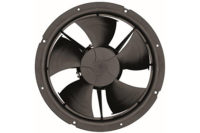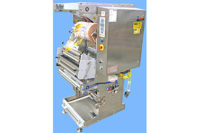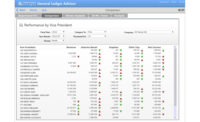How Reversible Air Flow Evaporators Reduce Freezing Time










Refrigeration’s most important application is the preservation of food. Cooling and freezing food effectively reduces the activity of microorganisms and enzymes, thus slowing its decay. Here’s how reversible air flow evaporators help cold food processors achieve longer freezing times and a variation in product quality based on placement in the freezer.
How fish freezes
Fish unloaded from the vessel are usually graded by the buyer according to species, size and minimum quality specification. A price is based in part on the quality in relation to market requirements. Fish also may be inspected by local and federal regulatory agencies for wholesomeness and sanitary conditions. Organoleptic criteria are most important for evaluating quality however there is a growing acceptance, particularly in Canada and some European countries, of objective chemical and physical tests as indexes of quality loss or spoilage.
Fishery industries can be at the forefront with equipment and systems for cooling and freezing products in order to be competitive in international markets. Also, international quality standards are increasingly stringent, which motivates these industries to compete more aggressively. To do so, refrigeration equipment manufacturers are developing technologies that allow producers and processors to be innovative in today’s competitive market.
Freezing is a method of food preservation that slows the physical changes and chemical and microbiological activity that cause deterioration in foods. Reducing temperature slows molecular and microbial activity in food, thus extending useful storage life. To be profitable, the refrigeration and freezing equipment must comply with specific requirements of the particular application.
The refrigeration and freezing of food is a complex process. Before freezing, the sensible heat of the product must be removed to lower its temperature to the initial freezing point. Freezing reduces the temperature of a product from ambient to storage level and changes most of the water in the product to ice.
Colmac Coil, Colville, Wash., has been manufacturing evaporators for applications in coolers and freezers since 1971, as both complete units and bare ones for installation in spiral freezers and fluidized bed tunnel freezers. Working with the needs of clients and designers of refrigeration systems, Colmac Coil developed a line of reversible air flow evaporator units.
Traditional blast freezers use an evaporator placed in the top half of the freezing chamber with the cooling air flowing one direction the entire time. The result is a longer freezing time and a variation in product quality based on its placement in the freezer. The product furthest from the air entrance takes longer to freeze, resulting in lower quality. The reversible air flow evaporator offers a number of advantages in the process of cooling and freezing:
- Shorter freezing times
- Reduced power consumption of the evaporator
- Reduced power consumption of the refrigeration system
- Uniform quality of frozen product throughout the batch
- Reduced defrost cycles required to clear the coil of frost
The design of reversible air flow evaporators allows the fan motors to operate fully in two directions of air flow, i.e. forced (blow through) or induced (draw through). This allows the rows of products that are initially in the back of the freezer to be switched to the front, reducing freezing time once the direction is reversed.
Why pre-cooling is a must
Refrigeration’s most important application is the preservation of food. Cooling and freezing food effectively reduces the activity of microorganisms and enzymes, thus slowing its decay. In addition, the crystallization of water reduces the amount of liquid water in food and inhibits microbial growth. Most food processors with cooling and freezing operations use air-blast convection heat transfer, and only a limited number of products are cooled or frozen by conduction heat transfer in spiral, flow and plate freezers.
Pre-cooling is the rapid removal of heat from freshly harvested fruits and vegetables before shipping, storage or processing. Prompt pre-cooling inhibits growth of microorganisms that cause decay and reduces enzymatic and respiratory activity and moisture loss. Thus, proper pre-cooling reduces spoilage and loss of pre-harvest freshness and quality.
During post-harvest handling and storage, fresh fruits and vegetables lose moisture through their skin by transpiration. If an excess of moisture is lost, this will result in commodity deterioration, such as shriveling or impaired flavor. To minimize losses through transpiration and increase market quality and shelf life, these products must be stored in a low-temperature, high-humidity environment. Pre-cooling requires a high cooling capacity and appropriate air flow in order to maintain commodities at a suitable and constant temperature. Thus, pre-cooling is typically a separate operation from refrigerated storage and requires specially designed equipment.
A seafood processor reduces freezing time
Baja Marine Foods SAPI de CV is a subsidiary of Tri-Marine Corp., San Pedro, Calif. Its main activity is catching, processing and freezing small sardines and squid. The plant originally had four freezers equipped with standard one-direction air flow evaporators. In October 2013, the plant was expanded to add an additional four freezers, into which eight reversible air flow evaporators were installed. A comparison of the reversible air flow evaporators to the original freezers revealed a reduction in freezing time by 20%. In addition, the product quality uniformly improved, reaching better prices in the market.
"This technology was chosen based on our many years of experience in freezing our products, and have found that the design offered by Colmac has manifested in shorter freezing time and consequently in cost savings and better quality,” says Adrian Gutierrez, general director of Baja Marine. “We are very pleased with the results so far, and we plan to continue using the technology of reversible air flow in our upcoming projects. "
Large corporations in the fishing industry on the west coast of the United States, Canada and Alaska now use standard evaporators with reversible air flow, providing energy savings, reduced freezing times, increased revenue and considerable quality improvement.
Looking for a reprint of this article?
From high-res PDFs to custom plaques, order your copy today!











